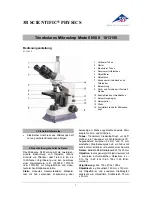
With a pinhole diameter <1AU, resolution improves (better
point separation thanks to a deeper dip), which is penalized
by a drastic loss in energy.
Moreover, it should be considered that it depends on the
signal level wich noise source dominates. With high-ampli-
tude signals (number of detected photons >10.000), laser
noise is the dominating effect, whereas the quality of low
signals (number of detected photons <1000) is limited by
the shot noise of the light.
Therefore, laser noise tends to be the decisive noise factor
in observations in the reflection mode, while shot noise
dominates in the fluorescence mode. With recent PMT
models (e.g., from Hamamatsu), detector dark noise is ex-
tremely low, same as secondary emission noise, and both
can be neglected in most practical applications (see Details
“Sources of Noise”).
Therefore, the explanations below are focused on the influ-
ence of shot noise on lateral resolution.
22
The main types of noise important in a confocal LSM system
are detector noise (dark noise, secondary emission noise),
laser noise, and shot noise of the light (see Details “Sources
of Noise”). As a rule, these sources of noise are of a sta-
tistical nature. Periodic noise rarely occurs, and if it does,
it tends to correlate with defective devices or mechanical
vibration in the setup; therefore it has been left out of
consideration here.
As said before the number of photons hitting the PMT de-
pends not only on the intensity of the fluorescence signal
(see Details “Fluorescence”), but also on the diameter of the
pinhole. The graph in figure 15 show the intensity distribu-
tion of a two-point object resulting behind the pinhole,
in normalized (left) and non-normalized form (right). The
pinhole diameter was varied between 2 AU and 0.05 AU.
At a diameter of 1 AU the pinhole just equals the size of the
Airy disk, so that there is only a slight loss in intensity. The
gain in lateral resolution, is minimum in this case.
Noise
1.0
0.8
0.6
0.4
0.2
0.5
1
1.5
2
d = 2.00 AU
d = 1.00 AU
d = 0.50 AU
d = 0.25 AU
d = 0.05 AU
[AU]
1.0
0.8
0.6
0.4
0.2
0.5
1
1.5
2
d = 2.00 AU
d = 1.00 AU
d = 0.50 AU
d = 0.25 AU
d = 0.05 AU
[AU]
Relative intensity
Fig. 15 As shown in Part 1, small pinhole diameters lead to improved resolution (smaller
FWHM, deeper dip – see normalized graph on the left).
The graph on the right shows, however, that constricting the pinhole is connected with a drastic
reduction in signal level. The drop in intensity is significant from PH <1 AU to PH = 0.05.
Summary of Contents for LSM 880
Page 1: ...LSM 880 LSM 880 NLO Operating Manual October 2014 ZEN 2 black edition...
Page 650: ......
Page 678: ......
Page 687: ......
Page 688: ......















































